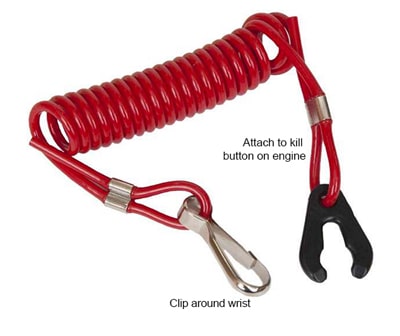
This article is an excerpt from NauticEd’s online Skipper Large Keelboats Course, a comprehensive online sailing course for beginner to intermediate sailors to learn how to sail large sailboats 26 ft (8m) and above. The Skipper Large Keelboats course is part of the Skipper Course Bundle of online courses, also teaching you how to master maneuvering under power and docking!
You can learn to sail and improve your sailing with NauticEd, the international leader in sailing education.
Dinghy Safety!
When it comes to dinghy operations, the following is a dangerous attitude: “It’s only a short distance ashore—jump in, she’ll be right!”
Operating a dinghy safely is often overlooked, yet this is when you are in the most danger. Here are some issues to think about. Mostly the issues come from thinking that the trip is short and safety concerns can be partially relaxed.

Operating a dinghy
Dinghy Operations
- Difficult to see: In a dinghy, you are low to the water and it is difficult to observe you. Often you’ve left the boat during daylight hours and returning at night. You forgot to prepare by taking a flashlight on board and so you are running dark.
- Falling over: There are no lifelines. The error margin for gaining your own balance is low. A dangerous spinning propeller is close.
- Inexperienced operators: Everyone is keen to drive the dinghy. What if someone fell out and the operator turned the engine the wrong way? In less than a second the prop could cause severe lacerations or even death. Balancing speed with total load and conditions requires experience.
- Operating close to breakers and shallows: Waves near the shore are a sure danger for capsize. And especially if the bottom is reef or coral cuts are going to occur. Never go side-on to a wave, especially approaching the beach. You cannot hold a dinghy against the force of even a small wave.
- Tide and weather: An incoming tide will sweep away your dinghy left on the beach. If you’re ashore for longer periods of time, ensure the weather will be conducive for your return.
- Often overloaded: Heading ashore often seems like a hassle to run more than one trip for the crew. Thus the dinghy tends to get overloaded with gear and crew. A wrong balance or an inopportune wave can cause disaster. Water rushing in over the front due to forward overload can also create havoc.
- Engine reliability: Outboards suffer from many issues. An engine failure at the wrong time can be dangerous. Ensure you have oars on board and plenty of fuel.
- Kill cord: This is a lanyard attached to the engine cutoff switch and the driver whenever the engine is running. If the driver is thrown overboard the engine will automatically cut off, enabling the driver to swim back to the dinghy AND preventing the propeller from chomping body parts.

- Life jackets and pumps: Often, the crew and parents tend to negate the need for life jackets due to a short trip or just not thinking this has obvious potential consequences. A deflating dinghy is not a fun feeling while in operation. Carry the pump.
- Boarding and getting out: Our rule for these operations is always to have three points touching something at any one time: for example two feet and one hand or two hands and one foot. An entry and exit like this tend not to look so graceful but are much more graceful than wet clothes, salt water in your drink, and a bonk on the head.
- No communications: Often the dinghy crew will neglect to carry on board any form of communication to rescue. A dinghy with a failed engine caught in a rip current is a disaster. Consider taking a VHF and perhaps flares.
- Returning from the bar: Drink driving laws are often overlooked when operating a dinghy—and besides, the chances of being caught are minimal, right? Yet the law is there for safety, not to randomly write tickets. Operating a dinghy drunk, while perhaps funny at first, can have serious consequences on the water at night.
- Secure the dinghy: “Excuse me—is this your dinghy?” This was the question we heard once from a fellow boater towing our dinghy. It’s pretty embarrassing! Don’t rely on inexperienced crew to tie a proper knot.
In general, you’ve been applying good seamanship to your entire cruise. Don’t slacken your guard around the dinghy.
Watch this dinghy training video:
Dinghy Training Video
You can learn more in the Skipper Course....
Knowledge and theory for longer distances and overnight sailing in diverse conditions. The Skipper Course is a comprehensive online sailing course for beginner to intermediate sailors wanting to learn how to sail larger sailboats 26ft to 56ft. Or upgrade to the Skipper Course Bundle of online courses to also master maneuvering under power and docking!
